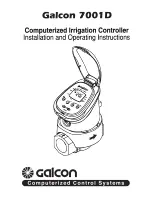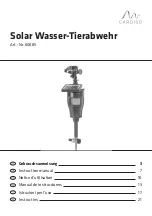
Manual 2100-721B
Page
44 of 54
• Locate the orange and blue wires on the terminal
block below the furnace control board.
• Switch the terminal landings on the terminal block.
• Close the control panel.
• To reduce the cooling airflow speed from high to
rated, reverse the blue and orange wires on the
terminal block below the furnace control board.
NOTE:
Be sure to adjust the system static or blower
speed to maintain airflows above the minimum
recommendations to prevent freeze up conditions
if Balanced Climate mode is activated.
Do not operate the unit in Balanced Climate mode
if running high static applications as indicated in
the blower performance table. If Balanced Climate
mode is activated as described on page 22, the unit
will run in this mode at all times unless there is a
call for ventilation, electric heat or 2nd stage cooling
from a 2-stage thermostat. At that time, the unit will
automatically activate a higher speed tap.
Blower Speeds
Five factory programmed speed taps (torque settings)
are available for the motor, and are selected through
different unit modes of operation. These modes are
energized by 24VAC signals from the low voltage
terminal block located inside the control panel by a
thermostat or other controlling device. Each speed tap
is programmed by Bard at the factory to different motor
torque settings (see Figure 25).
Multiple motor speed taps may be energized
simultaneously by 24VAC power during different modes
of operation. The highest number speed tap energized
takes priority with 5 being the highest and 1 being the
lowest.
FIGURE 25
Speed Taps
Speed Tap 1: Balanced Climate Speed
Speed Tap 2: Cool Speed
Speed Tap 3: Cool High Speed
Speed Tap 4: Heat Speed
Speed Tap 5: Heat High Speed
Manual
2100-467H
Page
23 of 23
FIGURE 11
TROUBLESHOOTING GE X13-SERIES ECM2.3
™
MOTORS
CONT’D.
Model X13 Communication Diagnostics
The X13 motor is communicated through 24 VAC low voltage
(Thermostat Control Circuit Wiring).
1.
Start with unit wiring diagram to confirm proper
connections and voltage (see Figure 11).
2. Initiate a demand from the thermostat and check the
voltage between the common and the appropriate motor
terminal (1-5). ("G" input is typically on terminal #1, but
refer to wiring diagram!)
a. If the low voltage communication is not present, check
the demand from the thermostat. Also check the
output terminal and wire(s) from the terminal strip or
control relay(s) to the motor.
b. If the motor has proper high voltage as identified
above (Motor not Running #1), and proper low voltage
to a programmed terminal, and is not operating, the
motor is failed, and will require replacement.
24VAC "R" Sig nal thro ug h
thermo stat o utp ut.
24VAC Co mmo n
24VAC Co mmo n
24VAC "R" Sig nal thro ug h
thermo stat o utp ut.
24VAC Common
24VAC "R"
signal through
thermostat output
FIGURE 24
Increasing Cooling Speed
TERMINAL
BLOCK
TERMINAL
BLOCK
BLUE
ORANGE/BLACK
ORANGE
TERMINAL
BLOCK
BLUE
ORANGE
ORANGE/BLACK
TERMINAL
BLOCK
BLUE
ORANGE
ORANGE/BLACK
MIS-4139
PURPLE
BLOWER
RELAY
BLACK/WHITE
BLUE
YELLOW/WHITE
ORANGE/BLACK
BLACK/WHITE
WIRE
ORANGE/BLACK
TERMINAL BLOCK IN REFERENCE TO LOCATION OF
BLUE
:
WIRE LOCATIONS ON
ORANGE
&
PLEASE NOTE
.
HIGH AIRFLOW
BLUE
ORANGE
B
ORANGE/BLACK
STANDARD RATED COOLING AIRFLOW
TO CHANGE FROM RATED TO HIGH
A
PINK
OPTIONAL
NOTE
A RATED AIRFLOW
B HIGH COOLING AIRFLOW
Содержание W24G4
Страница 14: ...Manual 2100 721B Page 14 of 54 FIGURE 2B Mounting Instructions for W42G W48G and W60G...
Страница 16: ...Manual 2100 721B Page 16 of 54 FIGURE 4 Wall Mounting Instructions FIGURE 5 Wall Mounting Instructions...
Страница 17: ...Manual 2100 721B Page 17 of 54 FIGURE 6 Common Wall Mounting Installations...
Страница 27: ...Manual 2100 721B Page 27 of 54 FIGURE 14 Gas Pipe Connection W24G W36G W42G W60G...











































